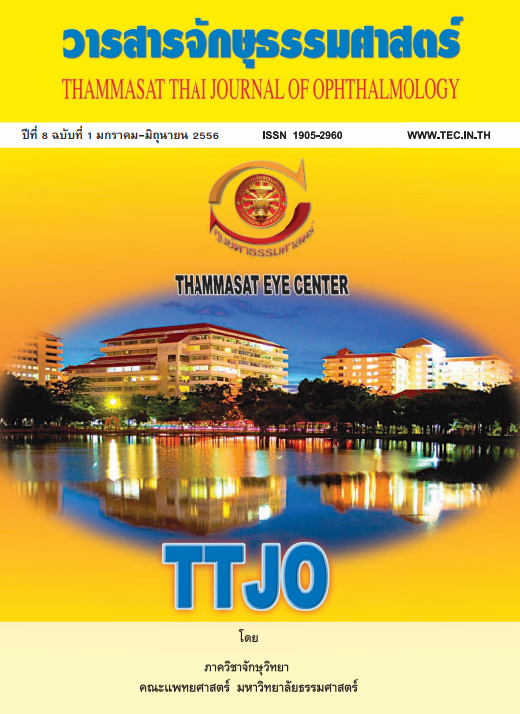Medulloblastoma Presented with Bilateral Sixth Cranial Nerve Palsies
Main Article Content
Abstract
A 16 years old healthy man presented with history of increasing frequency of headache and vomiting, notes of blurred vision and binocular horizontal diplopia for 1 month. Clinical findings revealed bilateral sixth nerve palsies with bilateral optic disc swelling. With all of these findings, this seem to be a case of raised intracranial pressure. Neuroimaging demonstrated a midline posterior fossa tumor with obstructive hydrocephalus. The patient underwent ventriculoperitoneal shunt and subtotal tumor removal. Pathological examination revealed histological characteristic findings of medulloblastoma. Patient was received the craniospinal radiation and chemotherapy to improve the survival. On follow-up visits, ocular examination revealed his diplopia improved and resolved of swollen disc both eyes.
Introduction: Medulloblastoma is the most common malignant brain tumor in children1. Early symptoms are secondary to increased intracranial pressure such as headache and vomiting. The earliest sign are nonlocalized and caused by increased intracranial pressure. Visual disturbances more commonly are a result of papilledema. Patient may develop double vision as the sixth cranial nerve becomes stretched from the hydrocephalus.2 Neurological deficits in extremity coordination and gait are common. Later signs due to brain stem invasion may cause conjugate gaze palsy and combination with deficits of multiple cranial nerves. 3 We describe the presentation of medulloblastoma in a young man presented with chronic intermittent headache and vomiting with increasing frequency of headache, blurred vision and binocular horizontal diplopia. The fundus evaluation revealed papilledema. The neurological examination revealed bilateral sixth nerve palsies and truncal ataxia. The presence of bilateral sixth nerve palsies and papilledema is seem to be evidence of increased intracranial pressure require urgent neuroimaging.4 Isolated sixth nerve palsies may be non-localizing signs but the presence of ataxia is also the localizing sign suggested the cerebellar involved lesion.5
Medulloblastoma presented with bilateral sixth cranial
nerve palsies
บทนำ
เนื้องอกสมองชนิด medulloblastoma เป็นเนื้องอกสมองชนิดร้ายแรงที่พบบ่อยที่สุดในเด็ก อาการสำคัญที่พบได้ในระยะแรกเริ่มมักเป็นผลมาจากความดันในสมองที่เพิ่มสูงขึ้น ได้แก่ อาการปวดศีรษะและมักพบอาการคลื่นไส้อาเจียนร่วมด้วย อาการเดินเซจากการทรงตัวผิดปกติ ในบางรายอาจมีอาการผิดปกติทางสายตาได้จากเกิดภาวะขั้วประสาทตาบวมจากความดันในสมองสูง บางรายเกิดอาการเห็นภาพซ้อน จากเส้นประสาทที่ควบคุมกล้ามเนื้อกลอกตาทำงานผิดปกติ การให้การวินิจฉัยแยกโรคโดยอาศัยประวัติ การตรวจตาและการทำงานของระบบประสาทอย่างละเอียด ร่วมกับการตรวจภาพถ่ายรังสีพิเศษเพิ่มเติมเช่น CT หรือ MRI และการตรวจน้ำไขสันหลังจะนำมาซึ่งการวินิจฉัยที่ถูกต้อง
รายงานผู้ป่วย : รายงานผู้ป่วยอายุน้อย 1 รายที่มาด้วยอาการปวดศีรษะเรื้อรังเป็นๆ หายๆ อาการปวดศีรษะดังกล่าวเป็นมากขึ้นมา 2 เดือนร่วมกับมีอาการคลื่นไส้อาเจียนตามัวลงทั้งสองข้างและมองเห็นภาพซ้อนในแนวนอนการตรวจพบมีตาเขเข้าในจากความผิดปกติของกล้ามเนื้อกลอกตา Lateral rectus ทั้งสองข้าง ตรวจจอประสาทตาพบมีการบวมขั้วประสาทตาทั้งสองข้าง การตรวจร่างกายทางระบบประสาทพบมีความผิดปกติในการทรงตัว ให้การวินิจฉัยเบื้องต้นว่ามีภาวะขั้วประสาทตาบวมสองข้างจากความดันในสมองสูง การตรวจเอกซเรย์คอมพิวเตอร์สมองพบเนื้องอกสมองบริเวณ cerebellum ภายหลังการทำระบายน้ำไขสันหลังเพื่อลดความดันในสมอง ผู้ป่วยได้รับการผ่าตัดเอาเนื้องอกสมองออก การตรวจทางพยาธิวิทยาพบลักษณะของเนื้องอกสมองชนิด medulloblastoma ซึ่งต้องได้รับการรักษาด้วยการฉายแสงและการให้เคมีบำบัดเพิ่มเติม การตรวจติดตามผู้ป่วยภายหลังการรักษาพบว่า ไม่มีอาการปวดศีรษะและคลื่นไส้อาเจียน ระดับการมองเห็นดีขึ้น อาการเห็นภาพซ้อนลดลงจากการทำงานของเส้นประสาทตาที่ควบคุมกล้ามเนื้อกลอกตากลับฟื้นดีขึ้นได้


